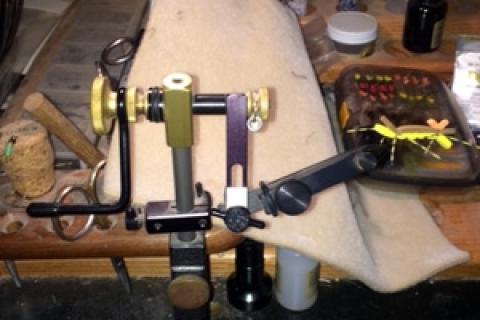
 Thinking about all the different equipment/materials a beginner fly tier needs to start tying, a quality fly tying vise should be on top of the list. Vises have evolved drastically over the last few years and for the beginner tier it can be hard to figure out exactly what are the most important features.
Thinking about all the different equipment/materials a beginner fly tier needs to start tying, a quality fly tying vise should be on top of the list. Vises have evolved drastically over the last few years and for the beginner tier it can be hard to figure out exactly what are the most important features.
There are three basic components to a vise that make them more or less desirable. First and foremost is the vise's operability. When we talk in terms of operability for vises we are talking specifically how easy it is to use the vise jaws. For example can the vise hold multiple sizes of hooks (ideally sizes 20 to 2/0)? Can the vise hold hooks in multiple positions? Is the vise able to hold onto a hook tightly or do you need to readjust the vise clamp frequently? If the answer to any of these questions is "no" or "not really" then you should figure that this vise will be ok to learn on but not much else. There are going to be a ton of skills and other things to worry about as you learn to tie flies and fumbling with a poorly operating vise just makes it tougher.
The base or c-clamp quality is the next part to the vise that tiers need to be suspect of. Much like the jaws, the c-clamp needs to be able to hold tight. It is essential that the vise stay stationary so that as you apply materials they will go on in an even fashion. If you plan on getting a vise with a pedestal base make sure that the base is heavy enough and wide enough to support the vise. You should be able to put pressure on hooks and the jaws without the base tipping or wobbling about.
Lastly, tiers need to judge a vise on its ability to rotate. The more you tie the more you will want the vise to be able to rotate. Having to remove hooks to invert them is a very slow way to apply materials, and as you get more comfortable with tying you will actually use the rotary action to palmer hackles and wrap ribbing. To judge a vise's rotation check to see how smoothly a vice rotates and if it has a one way spinning action. You want to be able spin the vise, but also have a stop so when you need to put pressure on the fly it won't spin freely. Another nice feature is to have a handle on the back end of the jaws to that you can manage (with your free hand) how fast or slow the fly turns.
There are a lot of small add-ons that might make one vise more attractive like bobbin cradle, or material clips, but to really find a good vise you need to take a look at the vise itself. Once you find a vise that fits your tying style and needs, it will bring you many years of tying enjoyment, and may inspire you to create your own flies.
Visit Bass Pro 1Source blogs to learn more about fly tying.
- 3901 views

